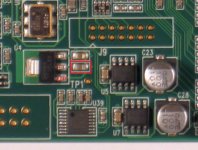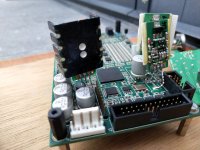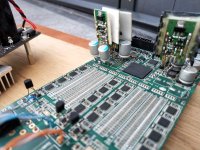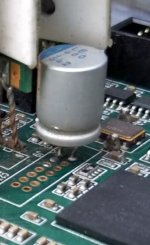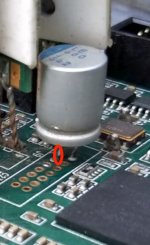Exactly, long term stability has no SQ impact, indeed we run our oscillators without an oven and we don't measure the Allan Deviation.
From a NDK paper (since you don't trust me):
"Frequency stability (the characteristic by which frequency does not change over an extended
period) is generally seen as an important property of crystal oscillators. However, audio devices
require short-term rather than long-term stability."
It is kind of obvious, isn't it?
However, in the case of the DAM1021, where a programmable oscillator is constantly prodded for readjustments (which might actually affect short-term stability) it may become relevant.
living sounds,
IMHO, the best two options are FIFO or ASRC. FIFO is bit perfect, but time delayed. ASRC attenuates jitter but does not eliminate it, no issue with delay.
IME, a PLL for MCLK and or a non-crystal MCLK is inferior to a well-implemented FIFO or ASRC by today's best standards of performance.
Only way to find out if it makes a practical difference for a particular listener with a particular reproduction system is to run the experiment and see what happens.
Very few people seem to be willing to do the work to find out, however. What that, I will stop here. Critics are welcome to have fun if they want.
IMHO, the best two options are FIFO or ASRC. FIFO is bit perfect, but time delayed. ASRC attenuates jitter but does not eliminate it, no issue with delay.
IME, a PLL for MCLK and or a non-crystal MCLK is inferior to a well-implemented FIFO or ASRC by today's best standards of performance.
Only way to find out if it makes a practical difference for a particular listener with a particular reproduction system is to run the experiment and see what happens.
Very few people seem to be willing to do the work to find out, however. What that, I will stop here. Critics are welcome to have fun if they want.
Last edited:
It is kind of obvious, isn't it?
However, in the case of the DAM1021, where a programmable oscillator is constantly prodded for readjustments (which might actually affect short-term stability) it may become relevant.
It looks like that for TNT it's not so obvious.
Yes, this is the point.
IMHO the PLL actually affects the short-term stability (that affects the SQ).
For a long time now, I use the dam1021 as my Dac for the Mastereffects Loop in my digital Studio. Sound is superior to my RME UFX DAC, but (!) there is always a little drift in relation to the UFX. It is irrelevant on the Mastermix, but annoying when you try to use it in parallel compressing and the like, the phase drifts and it is notable in some situations. So I cannot use the 1021 under those circumstances.In my case the issue is purely relative drift vs. the ADC clock (which is the master).
Jitter on the other hand is worse on the UFX, I did the J-Test on both DACs and the DAM has less jitter by some margin and that is even valid, when the UFX is master.
hip.sing,
J-test is for deterministic jitter only. You know, spurs. Not for random phase noise close to the carrier. That's much harder to make sense out of using an FFT, at least for now.
J-test is for deterministic jitter only. You know, spurs. Not for random phase noise close to the carrier. That's much harder to make sense out of using an FFT, at least for now.
For a long time now, I use the dam1021 as my Dac for the Mastereffects Loop in my digital Studio. Sound is superior to my RME UFX DAC, but (!) there is always a little drift in relation to the UFX. It is irrelevant on the Mastermix, but annoying when you try to use it in parallel compressing and the like, the phase drifts and it is notable in some situations. So I cannot use the 1021 under those circumstances.
Yes, that's the problem. Well that, and the fact that the source influences the sound. It does sound very good with both clocks though, and with the added decoupling to the 3.3V regulator there is little to complain either way.
It looks like we need a drift level vs. the ADC clock way below the nanosecond range to approach a null of 100 dB or more up to 20khz, which is certainly possible in theory, since other converters achieve it, too (a friendly member here provided me with a formula).
BTW, for some reason the DAM1021 also doesn't lock to a signal that is more than 1% off from the target standard sample rate. Maybe to prevent a situation with ambiguity wrt the correct filter.
Maybe I posted it already somewhere, but I was also kinda shocked by the magnitude of change just a better power supply for the Usb board made. Also played the dac already with Salas shunts, so it is well-fed. I was never really happy with the sound before, I thought that the onboard reclocking would cleanup everything before. How wrong I was...
As for the sound: lately I made an interesting comparison between the Soekris 1121 and a Denafrips Pontus, which has a substantial power supply and discreet clocks. I was afraid that the Soekris could have been left in the dust, but to my surprise it turned the other way around.
Denafrips sounded a little bit brighter, the Soekris warmer, with a less nervous background and more organic. No big differences, but clearly audible, and I preferred the Soekris.
Regarding the fact that the Denafrips is sold directly from the company and would normally cost double, I found that remarkable for a dac which can't sound good because of its clock.
So, as always, there is theory and there is the actual game.
Just wanted to share ...
As for the sound: lately I made an interesting comparison between the Soekris 1121 and a Denafrips Pontus, which has a substantial power supply and discreet clocks. I was afraid that the Soekris could have been left in the dust, but to my surprise it turned the other way around.
Denafrips sounded a little bit brighter, the Soekris warmer, with a less nervous background and more organic. No big differences, but clearly audible, and I preferred the Soekris.
Regarding the fact that the Denafrips is sold directly from the company and would normally cost double, I found that remarkable for a dac which can't sound good because of its clock.
So, as always, there is theory and there is the actual game.
Just wanted to share ...
How did you do the regulator decoupling? Picture? Seems I would like to do that too...
//
It is just a single polymer electrolytic between output and ground of the 3.3V regulator. I soldered it on top of the ceramic cap right next to it.
The board shown on the soekris.dk website looks like it has tracks going from the regulator to the cap, but on my revisions the orientation is reversed.
I've attached a foto with the position of the cap and the gnd and + out connection of the regulator marked. Make sure to determine the correct orientation for the polymer with a multimeter vs. those points on the regulator.
I used a 1500 uf cap, but that probably is excessive. The regulator's data sheet says that up to a 100uf cap can improve the transient response.
Attachments
It is just a single polymer electrolytic between output and ground of the 3.3V regulator. I soldered it on top of the ceramic cap right next to it.
There is an easier way to add a decoupling cap on the 3.3v, use the top vias of the J9 header.
Attachments
Yep, that's the one
On that picture you can also see the two decoupling towers I built around the clock,
the larger elcos of those towers are on the underside
On that picture you can also see the two decoupling towers I built around the clock,
the larger elcos of those towers are on the underside
Last edited:
Thanks!
Now how to do this also for the 1121 - I'll ask in that thread...
Building with the Soekris dam1121
//
Now how to do this also for the 1121 - I'll ask in that thread...
Building with the Soekris dam1121
//
Last edited:
There is an easier way to add a decoupling cap on the 3.3v, use the top vias of the J9 header.
Easier, yes, but I would prefer it to be closer to the regulator and the clock, also as close as possible to the cap already there to minimize resonances.
It is quite convenient to solder the polymer on top of the ceramic. I will do it for all 17 of my DAM1021 eventually.
- Home
- Vendor's Bazaar
- Reference DAC Module - Discrete R-2R Sign Magnitude 24 bit 384 KHz
